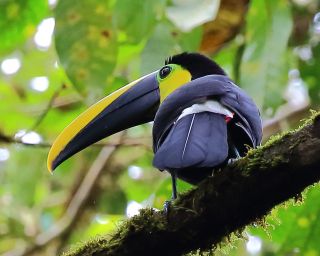Animal Behavior
Birds of a Feather: Mimicry Is Ingenious for Survival
Many birds are imposters and they can deceive each other.
Updated July 24, 2023 Reviewed by Ray Parker
Key points
- Smaller bird species may mimic larger, more dominant bird species to avoid interference and or aggression.
- Most birds lack depth perception, which makes interspecific deception feasible.
- In addition to birds, similar interspecific mimicry may also exist in other animal taxa.

If self-deception, also known as the Dunning-Kruger effect in psychology, is bad enough, then discovering that you’ve unknowingly embarrassed yourself can be devastating. Such was my experience during a social gathering at a bustling, rooftop bar in downtown Portland some years back when I mistakenly called Susie by Beckie.
Yet, the weight of this faux pas paled in comparison to the realization that my partial face blindness was playing an active role in the ordeal. How had my inner Dunning-Kruger kept me blissfully unaware of my cognitive flaw for so long?
My introspection delved deeper, unearthing not just facial recognition challenges, but also my difficulty in distinguishing objects that bear striking resemblances. As a passionate birder, this cognitive deficit often proved exasperating, leaving me unable to differentiate between similar species of hawks, woodpeckers, warblers, flycatchers, buntings, and sparrows—as if they were partaking in an avian conspiracy to taunt, mock, and vex me.
Yet, a glimmer of comfort emerged from recent revelations in the world of avian deception. It appears that many birds are indeed imposters, but not out of malevolence toward my cognitive limitations. No, their masquerade is an ingenious survival strategy: Mimicry.
This marvel of deception was observed as early as the mid-19th century, thanks to the astute eye of naturalist Alfred Russel Wallace, who co-discovered evolution by natural selection with Charles Darwin. However, it took the meticulous research of Richard Prum and his team at Yale University to shed light on the scientific intricacies of this avian charade.
Enter the enchanting duo, the downy and hairy woodpeckers, harmoniously coexisting across substantial swaths of North America—or so we used to think. Despite the stark difference in body mass with the downy less than half that of the hairy, these two species bear a striking resemblance to each other.
They are often hopping amid tree branches in my yard as if staging an avian game of “spot the difference.” Yet, this avian sleight of hand lies in their optical illusion of size perception: a hairy woodpecker positioned 7.5 meters (8.2 yards) away shrinks to the size of a downy woodpecker, merely 5 meters (5.5 yards) distant.
Moreover, most birds, excluding the keen-eyed raptors, contend with weak binocular vision, compromising their depth perception. That explains why pet birds—chickens, pigeons, parakeets— would inspect us in close range with endearing head tilts, using one eye at a time. But estimating size with the same method becomes a whimsical adventure that quickly loses accuracy as the distance grows. (You can try this with a single eye for a similar experience.) Prum estimates that, for most birds, a mimic species may be able to deceive its model counterpart from 2 to 3 meters (6.6 to 9.8 feet) away.
How can you discern the true imitator between the downy and hairy woodpeckers? To unravel this avian riddle, we must ascertain that their similar plumage is not merely a result of shared ancestry, as offspring inherit traits from parents.
The scientific verdict delivered by Amy Weibel and William Moore of Wayne State University in Detroit revealed that the downy and hairy woodpeckers do not share the closest kinship among woodpecker species. Instead, they now reside in different genera: Picoides for the downy and Leuconotopicus for the hairy.
Therefore, their plumage similarity most likely arose from evolutionary convergence, like the independent reinvention of the wheel across diverse ancient cultures. This revelation brings forth the essence of mimicry, where one species deftly impersonates the other. The pressing question remains: Who is the true mimic, the downy or the hairy?
Prum and his collaborator, Larry Samuelson, turned their eyes toward the attributes of dominance. Apparently, the bulkier and more dominant hairy woodpecker proves less likely to initiate aggression when faced with another hairy. Thus, the downy woodpecker, taking a cue from the realm of strategic thinking, adorns itself with a hairy disguise, avoiding frequent run-ins with “Hairy-The Bully.”
The clever ruse grants “Downy-The Weeny” precious time for essential activities, such as feeding and reproduction, untouched by the rude interferences of its larger counterpart. With this scenario in mind, Prum and Samuelson resorted to a game theory approach, demonstrating how a mimic “Downy-The Sneaky" can outdo a non-mimic “Downy-The Weeny” in evolution.
But the saga of avian deception does not rest with the hairy-downy duo alone. Prum, the tireless bird detective, extends his avian investigation to uncover a formidable cast of 93 suspected imposters, spanning 30 bird families worldwide. From shorebirds to toucans, hawks, flycatchers, and woodpeckers, a grand ensemble of feathered actors participates in this avian masquerade.
Each mimic, typically 56 percent to 58 percent the size of its model counterpart, stands to gain similar advantages by emulating larger, more dominant species in their habitats.
Behold the intriguing emergence of “Prumian mimicry,” a phenomenon that apparently defies existing avian mimicry classifications, leaving scientists both captivated and eager for more empirical evidence. The implications of this feathered intrigue extend beyond avian realms, hinting at the tantalizing prospect of interspecific deception across diverse taxa: fish, amphibians, reptiles, and mammals may possess their own repertoire of cunning charades. Prum looks to coral reef communities as a promising setting for unearthing interspecific mimicry among various fish species.


As we venture deeper into the amazing landscape of natural deception, we embrace the whimsical humor of nature’s enchanting theater, where every creature, great and small, dances to its unique beat, leaving us with a blend of awe and laughter.
References
Weibel, A. C., & Moore, W. S. (2005). Plumage convergence in Picoides woodpeckers based on a molecular phylogeny, with emphasis on convergence in downy and hairy woodpeckers. The Condor, 107(4), 797-809.
Prum, R. O., & Samuelson, L. (2012). Evolution of interspecific social dominance mimicry modeled by the “Hairy-Downy” game. J Theor Biol, 313, 42-60.
Prum, R. O. (2014). Interspecific social dominance mimicry in birds. Zoological Journal of the Linnean Society, 172(4), 910-941.
Prum, R. O., & Samuelson, L. (2016). Mimicry cycles, traps, and chains: the coevolution of toucan and kiskadee mimicry. The American Naturalist, 187(6), 753-764.




